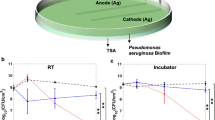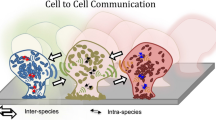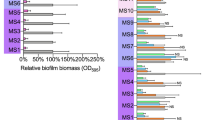Abstract
Microbial biofilms are highly refractory to antimicrobials. The aim of this study was to investigate the use of low-frequency vibration therapy (20–20 kHz) on antibiotic-mediated Pseudomonas aeruginosa biofilm eradication. In screening studies, low-frequency vibrations were applied on model biofilm compositions to identify conditions in which surface standing waves were observed. Alginate surface tension and viscosity were also measured. The effect of vibration on P. aeruginosa biofilms was studied using a standard biofilm assay. Subminimal inhibitory concentrations (sub-MIC) of tobramycin (5 μg/ml) were added to biofilms 3 h prior, during, and immediately after vibration and quantitatively assessed by (2,3-bis-(2-methoxy-4-nitro-5-sulfophenyl)-2H-tetrazolium-5-carboxanilide) reduction assay (XTT) and, qualitatively, by confocal laser scanning microscopy (CLSM). The standing waves occurred at frequencies <1,000 Hz. Biofilms vibrated without sub-MIC tobramycin showed a significantly reduced metabolism compared to untreated controls (p < 0.05). Biofilms treated with tobramycin and vibrated simultaneously (450, 530, 610, and 650 Hz), or vibrated (450 and 650 Hz) then treated with tobramycin subsequently, or vibrated (610Hz, 650Hz) after 3 h of tobramycin treatment showed significantly lower metabolism compared to P. aeruginosa biofilm treated with tobramycin alone (p < 0.05). CLSM imaging further confirmed these findings. Low frequency vibrations assisted tobramycin in killing P. aeruginosa biofilms at sub-MIC. Thus, sound waves together with antibiotics are a promising approach in eliminating pathogenic biofilms.




Similar content being viewed by others
References
Costerton JW, Stewart PS, Greenberg EP. Bacterial biofilms: a common cause of persistent infections. Science. 1999;284(5418):1318–22. Epub 1999/05/21.
Samaranayake LP. Essential microbiology for dentistry. Edinburgh: Churchill Livingstone; 2006.
Hall-Stoodley L, Costerton JW, Stoodley P. Bacterial biofilms: from the natural environment to infectious diseases. Nat Rev Microbiol. 2004;2(2):95–108. Epub 2004/03/26.
Donlan RM, Costerton JW. Biofilms: survival mechanisms of clinically relevant microorganisms. Clin Microbiol Rev. 2002;15(2):167–93. Epub 2002/04/05.
Bagge N, Hentzer M, Andersen JB, Ciofu O, Givskov M, Hoiby N. Dynamics and spatial distribution of beta-lactamase expression in Pseudomonas aeruginosa biofilms. Antimicrob Agents Chemother. 2004;48(4):1168–74. Epub 2004/03/30.
Vuong C, Kocianova S, Voyich JM, Yao Y, Fischer ER, DeLeo FR, et al. A crucial role for exopolysaccharide modification in bacterial biofilm formation, immune evasion, and virulence. J Biol Chem. 2004;279(52):54881–6. Epub 2004/10/27.
Zhang L, Mah TF. Involvement of a novel efflux system in biofilm-specific resistance to antibiotics. J Bacteriol. 2008;190(13):4447–52. Epub 2008/05/13.
Woods E, Davis P, Barnett J, Percival SL. Wound healing, immunology and biofilms. In: Percival SL, Cutting K, editors. Microbiology of wounds. London: CRC Press; 2010. p. 271–92.
Parsek MR, Singh PK. Bacterial biofilms: an emerging link to disease pathogenesis. Annu Rev Microbiol. 2003;57:677–701. Epub 2003/10/07.
Bjarnsholt T, Kirketerp-Moller K, Jensen PO, Madsen KG, Phipps R, Krogfelt K, et al. Why chronic wounds will not heal: a novel hypothesis. Wound Repair Regen. 2008;16(1):2–10. Epub 2008/01/24.
Bjarnsholt T, Jensen PO, Burmolle M, Hentzer M, Haagensen JA, Hougen HP, et al. Pseudomonas aeruginosa tolerance to tobramycin, hydrogen peroxide and polymorphonuclear leukocytes is quorum-sensing dependent. Microbiology. 2005;151(Pt 2):373–83. Epub 2005/02/09.
Jensen PO, Bjarnsholt T, Phipps R, Rasmussen TB, Calum H, Christoffersen L, et al. Rapid necrotic killing of polymorphonuclear leukocytes is caused by quorum-sensing-controlled production of rhamnolipid by Pseudomonas aeruginosa. Microbiology. 2007;153(Pt 5):1329–38. Epub 2007/04/28.
Alhede M, Bjarnsholt T, Jensen PO, Phipps RK, Moser C, Christophersen L, et al. Pseudomonas aeruginosa recognizes and responds aggressively to the presence of polymorphonuclear leukocytes. Microbiology. 2009;155(Pt 11):3500–8. Epub 2009/08/01.
Van Gennip M, Christensen LD, Alhede M, Phipps R, Jensen PO, Christophersen L, et al. Inactivation of the rhlA gene in Pseudomonas aeruginosa prevents rhamnolipid production, disabling the protection against polymorphonuclear leukocytes. APMIS. 2009;117(7):537–46. Epub 2009/07/15.
Percival SL, Hill KE, Williams DW, Hooper SJ, Thomas DW, Costerton JW. A review of the scientific evidence for biofilms in wounds. Wound Repair Regen. 2012;20(5):647–57. Epub 2012/09/19.
Driscoll JA, Brody SL, Kollef MH. The epidemiology, pathogenesis and treatment of Pseudomonas aeruginosa infections. Drugs. 2007;67(3):351–68. Epub 2007/03/06.
Brem H, Stojadinovic O, Diegelmann RF, Entero H, Lee B, Pastar I, et al. Molecular markers in patients with chronic wounds to guide surgical debridement. Mol Med. 2007;13(1–2):30–9. Epub 2007/05/23.
Tomic-Canic M, Ayello EA, Stojadinovic O, Golinko MS, Brem H. Using gene transcription patterns (bar coding scans) to guide wound debridement and healing. Adv Skin Wound Care. 2008;21(10):487–92. quiz 93–4; Epub 2008/10/07.
Nusbaum AG, Kirsner RS, Charles CA. Biofilms in dermatology. Skin ther lett. 2012;17(7):1–5. Epub 2012/07/25.
Wolcott RD, Rumbaugh KP, James G, Schultz G, Phillips P, Yang Q, et al. Biofilm maturity studies indicate sharp debridement opens a time-dependent therapeutic window. J Wound Care. 2010;19(8):320–8. Epub 2010/09/21.
Ammons MC. Anti-biofilm strategies and the need for innovations in wound care. Recent patents on anti-infect drug discov. 2010;5(1):10–7. Epub 2009/10/08.
Wiesemann HG, Steinkamp G, Ratjen F, Bauernfeind A, Przyklenk B, Doring G, et al. Placebo-controlled, double-blind, randomized study of aerosolized tobramycin for early treatment of Pseudomonas aeruginosa colonization in cystic fibrosis. Pediatr Pulmonol. 1998;25(2):88–92. Epub 1998/03/27.
Frederiksen B, Koch C, Hoiby N. Antibiotic treatment of initial colonization with Pseudomonas aeruginosa postpones chronic infection and prevents deterioration of pulmonary function in cystic fibrosis. Pediatr Pulmonol. 1997;23(5):330–5. Epub 1997/05/01.
Doring G, Conway SP, Heijerman HG, Hodson ME, Hoiby N, Smyth A, et al. Antibiotic therapy against Pseudomonas aeruginosa in cystic fibrosis: a European consensus. Eur Respir J. 2000;16(4):749–67. Epub 2000/12/06.
Monsen T, Lovgren E, Widerstrom M, Wallinder L. In vitro effect of ultrasound on bacteria and suggested protocol for sonication and diagnosis of prosthetic infections. J Clin Microbiol. 2009;47(8):2496–501. Epub 2009/06/19.
Bigelow TA, Northagen T, Hill TM, Sailer FC. The destruction of Escherichia coli biofilms using high-intensity focused ultrasound. Ultrasound Med Biol. 2009;35(6):1026–31. Epub 2009/01/28.
Ioannou I, Dimitriadis N, Papadimitriou K, Sakellari D, Vouros I, Konstantinidis A. Hand instrumentation versus ultrasonic debridement in the treatment of chronic periodontitis: a randomized clinical and microbiological trial. J Clin Periodontol. 2009;36(2):132–41. Epub 2009/02/12.
Kirzhner F, Zimmels Y, Malkovskaja A, Starosvetsky J. Removal of microbial biofilm on water hyacinth plants roots by ultrasonic treatment. Ultrasonics. 2009;49(2):153–8. Epub 2008/10/28.
Piyasena P, Mohareb E, McKellar RC. Inactivation of microbes using ultrasound: a review. Int J Food Microbiol. 2003;87(3):207–16. Epub 2003/10/07.
Lambert PA. Mechanisms of antibiotic resistance in Pseudomonas aeruginosa. J R Soc Med. 2002;95 Suppl 41:22–6. Epub 2002/09/10.
Ryder C, Byrd M, Wozniak DJ. Role of polysaccharides in Pseudomonas aeruginosa biofilm development. Curr Opin Microbiol. 2007;10(6):644–8. Epub 2007/11/06.
Pedersen SS, Kharazmi A, Espersen F, Hoiby N. Pseudomonas aeruginosa alginate in cystic fibrosis sputum and the inflammatory response. Infect Immun. 1990;58(10):3363–8. Epub 1990/10/01.
Kumar S. Mechanism for the faraday instability in viscous liquids. Phys Rev E Stat Phys Plasmas Fluids Relat Interdiscip Topics. 2000;62 (1 Pt B):1416–9. Epub 2000/11/23.
Edwards WS, Fauve S. Patterns and quasi-patterns in the Faraday experiment. J Fluid Mech. 1994;278:123–48.
Flemming HC, Neu TR, Wozniak DJ. The EPS matrix: the “house of biofilm cells”. J Bacteriol. 2007;189(22):7945–7. Epub 2007/08/07.
Kilbourn JP. Bacterial content and ionic composition of sputum in cystic fibrosis. Lancet. 1978;1(8059):334. Epub 1978/02/11.
Govan JR, Deretic V. Microbial pathogenesis in cystic fibrosis: mucoid Pseudomonas aeruginosa and Burkholderia cepacia. Microbiol Rev. 1996;60(3):539–74. Epub 1996/09/01.
Bandara HM, Yau JY, Watt RM, Jin LJ, Samaranayake LP. Pseudomonas aeruginosa inhibits in-vitro Candida biofilm development. BMC Microbiol. 2010;10:125. Epub 2010/04/27.
Klepser ME, Ernst EJ, Ernst ME, Messer SA, Pfaller MA. Evaluation of endpoints for antifungal susceptibility determinations with LY303366. Antimicrob Agents Chemother. 1998;42(6):1387–91. Epub 1998/06/13.
Xu X, Zhou XD, Wu CD. The tea catechin epigallocatechin gallate suppresses cariogenic virulence factors of Streptococcus mutans. Antimicrob Agents Chemother. 2011;55(3):1229–36. Epub 2010/12/15.
Bandara HM, Lam OL, Watt RM, Jin LJ, Samaranayake LP. Bacterial lipopolysaccharides variably modulate in vitro biofilm formation of Candida species. J Med Microbiol. 2010;59(Pt 10):1225–34. Epub 2010/06/26.
Jefferson KK, Goldmann DA, Pier GB. Use of confocal microscopy to analyze the rate of vancomycin penetration through Staphylococcus aureus biofilms. Antimicrob Agents Chemother. 2005;49(6):2467–73. Epub 2005/05/27.
Walters 3rd MC, Roe F, Bugnicourt A, Franklin MJ, Stewart PS. Contributions of antibiotic penetration, oxygen limitation, and low metabolic activity to tolerance of Pseudomonas aeruginosa biofilms to ciprofloxacin and tobramycin. Antimicrob Agents Chemother. 2003;47(1):317–23. Epub 2002/12/25.
Fux CA, Wilson S, Stoodley P. Detachment characteristics and oxacillin resistance of Staphyloccocus aureus biofilm emboli in an in vitro catheter infection model. J Bacteriol. 2004;186(14):4486–91. Epub 2004/07/03.
Stoodley P, Wefel J, Gieseke A, Debeer D, von Ohle C. Biofilm plaque and hydrodynamic effects on mass transfer, fluoride delivery and caries. J Am Dent Assoc. 2008;139(9):1182–90. Epub 2008/09/03.
de Beer D, Stoodley P, Lewandowski Z. Measurement of local diffusion coefficients in biofilms by microinjection and confocal microscopy. Biotechnol Bioeng. 1997;53(2):151–8. Epub 1997/01/20.
Lenz AP, Williamson KS, Pitts B, Stewart PS, Franklin MJ. Localized gene expression in Pseudomonas aeruginosa biofilms. Appl Environ Microbiol. 2008;74(14):4463–71. Epub 2008/05/20.
Hall-Stoodley L, Stoodley P. Evolving concepts in biofilm infections. Cell Microbiol. 2009;11(7):1034–43. Epub 2009/04/21.
Lewis K. Persister cells. Annu Rev Microbiol. 2010;64:357–72. Epub 2010/06/10.
Kopel M, Degtyar E, Banin E. Surface acoustic waves increase the susceptibility of Pseudomonas aeruginosa biofilms to antibiotic treatment. Biofouling. 2011;27(7):701–10. Epub 2011/07/08.
Rediske AM, Hymas WC, Wilkinson R, Pitt WG. Ultrasonic enhancement of antibiotic action on several species of bacteria. J Gen Appl Microbiol. 1998;44(4):283–8. Epub 2002/12/27.
Rediske AM, Rapoport N, Pitt WG. Reducing bacterial resistance to antibiotics with ultrasound. Lett Appl Microbiol. 1999;28(1):81–4. Epub 1999/02/25.
Qian Z, Sagers RD, Pitt WG. Investigation of the mechanism of the bioacoustic effect. J Biomed Mater Res. 1999;44(2):198–205. Epub 1999/07/09.
Jayaraman A, Wood TK. Bacterial quorum sensing: signals, circuits, and implications for biofilms and disease. Annu Rev Biomed Eng. 2008;10:145–67. Epub 2008/07/24.
Pitt WG, Ross SA. Ultrasound increases the rate of bacterial cell growth. Biotechnol Prog. 2003;19(3):1038–44. Epub 2003/06/07.
Carmen JC, Nelson JL, Beckstead BL, Runyan CM, Robison RA, Schaalje GB, et al. Ultrasonic-enhanced gentamicin transport through colony biofilms of Pseudomonas aeruginosa and Escherichia coli. J of infect and chemother : off j of the Japan Soc of Chemother. 2004;10(4):193–9. Epub 2004/09/15.
Qian Z, Stoodley P, Pitt WG. Effect of low-intensity ultrasound upon biofilm structure from confocal scanning laser microscopy observation. Biomaterials. 1996;17(20):1975–80. Epub 1996/10/01.
Dror N, Mandel M, Hazan Z, Lavie G. Advances in microbial biofilm prevention on indwelling medical devices with emphasis on usage of acoustic energy. Sensors (Basel). 2009;9(4):2538–54. Epub 2009/01/01.
McGill SL. An evaluation of the use of superparamagnetic iron oxide nanoparticles to overcome extracellular barriers to lung disease for drug delivery. Austin, Texas, USA: The University of Texas at Austin, USA; 2011.
Stoodley P, Cargo R, Rupp CJ, Wilson S, Klapper I. Biofilm material properties as related to shear-induced deformation and detachment phenomena. J Ind Microbiol Biotechnol. 2002;29(6):361–7. Epub 2002/12/17.
Hazan Z, Zumeris J, Jacob H, Raskin H, Kratysh G, Vishnia M, et al. Effective prevention of microbial biofilm formation on medical devices by low-energy surface acoustic waves. Antimicrob Agents Chemother. 2006;50(12):4144–52. Epub 2006/08/31.
Wright JB, Costerton JW, McCoy WF. Filamentous growth of Pseudomonas aeruginosa. J Ind Microbiol. 1988;3:139–46.
Jensen RH, Woolfolk CA. Formation of filaments by Pseudomonas putida. Appl Environ Microbiol. 1985;50(2):364–72. Epub 1985/08/01.
Yoon MY, Lee KM, Park Y, Yoon SS. Contribution of cell elongation to the biofilm formation of Pseudomonas aeruginosa during anaerobic respiration. PLoS ONE. 2011;6(1):e16105. Epub 2011/01/27.
Author information
Authors and Affiliations
Corresponding author
Rights and permissions
About this article
Cite this article
Bandara, H.M.H.N., Harb, A., Kolacny, D. et al. Sound Waves Effectively Assist Tobramycin in Elimination of Pseudomonas aeruginosa Biofilms In vitro . AAPS PharmSciTech 15, 1644–1654 (2014). https://doi.org/10.1208/s12249-014-0200-1
Received:
Accepted:
Published:
Issue Date:
DOI: https://doi.org/10.1208/s12249-014-0200-1




